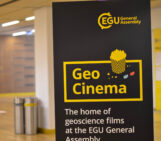This year was the first ever EGU Communicate Your Science Video Competition, an opportunity for young scientists to share their research with the wider public. It was also the first year to have a science film workshop at the Assembly – one to meet the needs of budding science communicators at the conference. Dan Brinkhuis from ScienceMedia.nl and Maarten Roos of Lightcurve Films set out to share their film making experience with eager EGU 2014ers last month. Here are their take-home messages…
First things first
Communicating science to a wider audience is becoming an increasingly important part of academic research. Funding bodies are calling for evidence of demonstrable impact and, with that, the need to share scientific work more widely, across both political and public spheres, is becoming increasingly clear. Sharing research straight from the scientists is also a fantastic way to get the next generation excited about science. There are many ways to do this: outreach events, blogs, public lectures, social media and more. Science films are just one of the many tools in the science communication toolbox. So, first things first: is film the right thing for you? Think about what you want to achieve, who you’re targeting and whether this medium will deliver that message to those people. It may be that other tools are better for the job.

Or must they? Make sure film is right for you before you start. (Credit: Dan Brinkhuis/Maarten Roos)
If you’ve picked film out of the toolbox then there’s a little prep work to do before you grab your camera and get going: consider the budget, the way the project will be managed and how you’re going to evaluate its success. Brinkhuis has put together a brilliant checklist on things to do before you film, be sure to check it before you get started.
One of the key things to work out before you get going is how much it’s all going to cost. While some grants have funds set aside for outreach, and others are specifically designed to support science communication projects, scientific filming is often done on a low budget. And there’s no reason for this to mean you have to compromise on quality. With SLR cameras and GoPros capable of recording fantastic footage in unfathomable conditions, there’s no need to splash out on swish tech. The same goes for sound: a simple collar microphone – the sort you might find at your favourite geoscience conference – often does the trick. If you need a little music, keep your eye out for Creative Commons pieces – they make a great backing track and they’re free to use.

Okay, so the kind of cameras you’ll be using are a little more advanced than this, but it looks good, right? (Credit: Flickr user Isaac)
You’ve got the kit, what next?
When making a science video it’s critical to catch your audience’s attention in the first 20-30 seconds, especially if they’re browsing YouTube after a long day at work. You have a lot of hilarious cat videos to compete with and if your film doesn’t grab them, the clip of Mister Tickles falling off the kitchen counter, into the dog bowl and leaping 5 feet in fright will. In a rough analysis of some of NASA’s YouTube videos, Roos found that animations and data – the clips that were the most visually engaging – were also the most successful means of keeping an audience glued to the screen. So, if you want to share science on screen successfully, keep it visually interesting!

A rough analysis of what makes a successful science video on YouTube. (Credit: Maarten Roos)
Having a fast-paced intro and visually engaging material is just part of the process. To really hit home you need to tell a story. This is something that also applies to science writing, and is a wonderful way of letting readers, viewers and listeners alike see where the spark for a particular investigation came from, how the scientific process has unfolded and, crucially, why it is important. If you’re unsure where to start with the story, think about why you’re investigating that topic, what inspires you about your project and what problems you hope to solve as you carry it out. Share that enthusiasm with your audience.
So what do you do if you simply want to record a scientific presentation, but make sure it’s a useful tool for later? Roos recommends putting yourself in the viewer’s shoes – not simply making a record of the presentation, but seeing it from the eyes of the audience members, so the viewer feels like they were there. Here’s his guide to filming and effectively editing presentations and lectures.
These are just the basics, but you can catchup on the full presentation and the tips and tricks talked about on Twitter online – almost as if you were at the workshop!
By Sara Mynott, EGU Communications Officer





Pingback: GeoLog | My film is ready, now what?
Bárbara Ferreira
This is great Sara, thanks for summarising the session for those of us who couldn’t attend. Looks like it was an excellent workshop!